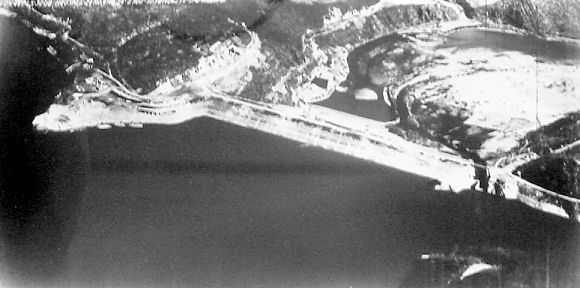CHAPTER III
The 707th Tank Battalion in support of the 28th Infantry Division
The 28th Infantry Division, supported by the 707th Tank Battalion, relieved the depleted 9th Infantry Division in the vicinity of GERMETER on 28 October and prepared to continue the assault to the ROER RIVER DAMS. Previous to the fall of AACHEN on 21 October, the bulk of General Hodges' First Army forces were engaged in the reduction of that city. After that date he was able to regroup his divisions for the attack to seize crossings of the ROER RIVER. VII Corps was to make the main effort to cross the ROER near DÜREN, while as a necessary preliminary to this crossing, V Corps was to seize the dams in the vicinity of SCHMIDT.

The Schammenauel Dam
The objective assigned to the 28th Division by V Corps was the area VOSSSENACK-STRAUCH-SCHMIDT. SCHMIDT was an important communications center located astride an east-west road which First Amy wanted for an MSR and in addition was on a ridge overlooking the SCHWAMMENAUEL (F058273), one of the vital ROER dams. East of the division and in the center of its sector lay the town of VOSSENACK atop an east-west ridge surrounded by woods. To the north lay the HÜRTGEN-BRANDENBERG-BERGSTEIN ridge which dominated the VOSSENACK ridge as did the ridge on which lay the towns of SCHMIDT and KOMMERSCHEIDT (F057309). (See Appendix I.)
The division plan of attack provided for the 109th Regiment to be committed on the north flank in the direction of the town of HÜRTGEN the 110th Regiment on the south toward SIMONSKALL (F023306), and the 112th Regiment in the center to take in turn, the towns of VOSSENACK, KOMMERSCHEIDT, and SCHMIDT. The 707th Tank Battalion commanded by Lt Col Richard Ripple was to support the attack. This battalion had joined the 28th on 6 October and up to the time of the HÜRTGEN operation had seen very little combat. In this operation the 707th fought mostly in support of the center regiment.

Colonel Richard W. Ripple
In front of the division on both north and south were dense forests cut by deep draws and hiding numerous defenses such as pillboxes, anti-tank and anti-personnel mines, and other types of man-made obstacles. In the center was the open ridge on which lay the town of VOSSENACK. Southeast of VOSSENACK and separating it from SCHMIDT was the KALL RIVER running through a steep wooded gorge. This river was crossed only by a small woods trail which connected VOSSENACK and KOMMERSCHEIDT and which was to become the MSR for the forces south of the KALL.

Before the attack the division G-2 estimated that to the immediate front the enemy had approximately 3350 men, to the north 1940, and to the south 1850, all fighting as infantry, under control of the 89th Infantry Division.
Reserves capable of rapid intervention were estimated at 2000 not committed and 3000 from less active fronts.
The attack, which was scheduled to jump off on 31 October, was delayed daily because of bad weather and was finally made on 2 November. Adverse weather continued, but it was decided the attack could no longer be delayed.

